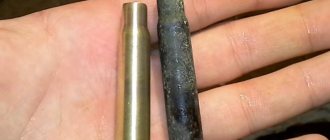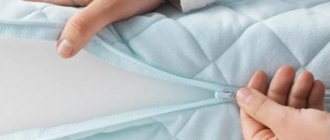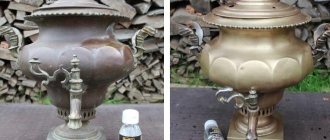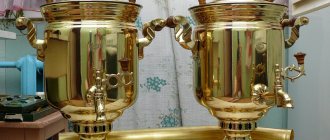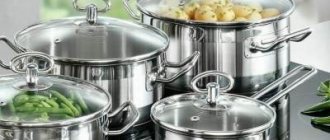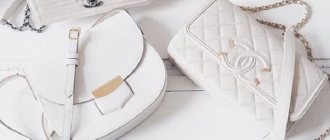Brass products can be found in almost every home. In this article we will talk about how and with what to clean brass at home quickly and effectively. Brass items have long gained popularity due to their unique properties - high strength, attractive color and luxurious shine.
Did you know that the first samovars were made of brass? This metal is still a popular material for making kitchen utensils today.
A LITTLE ABOUT BRASS
Brass is an alloy of copper and zinc. It is the percentage of the latter that is the determining factor in the presence of certain properties and qualities. The average level of zinc presence is considered to be from 20 to 45%.
As a material, brass is different:
- Ease of processing under pressure;
- Good indicators of anti-corrosion resistance;
- Increasing ductility at low temperatures, while strength does not decrease;
- Increased fragility when exposed to temperatures from 200 to 600 degrees;
- Good anti-friction properties;
- Good ability to weld with other metals.
Brass is one of the most popular alloys both in production and in everyday life. In this regard, questions about caring for alloy objects and how to clean brass and how to clean brass at home . By the way, if you are interested in the manufacture of reinforcement frames, you can read here: https://plazmetal.ru/armaturnye-karkasy.html.
Video
We all know how it happens: I put a saucepan on the stove, went online... Fathers, the water has already completely boiled away! And okay, if there were potatoes or eggs in the pan, but what if you have to clean up burnt jam? And if it also leaked onto the stove, then we sympathize with you twice. It’s not easy to clean both dishes and equipment from a layer of burnt sugar, but don’t throw them away! So be patient and try the following tricks to make things easier for yourself.
PREPARATION FOR CLEANING BRASS
Before you begin cleaning brass, the material must be prepared. Preparation for cleaning brass at home consists of the following activities:
- Determining whether an alloy belongs to brass. Namely, whether the material is pure brass or has impurities. To do this, they usually use a magnet, which attracts the brass;
- The feasibility and safety of the upcoming brass cleaning is assessed. It is usually not recommended to clean antiques yourself due to the risk of damaging the patina layer that performs a protective function;
- Immediately before starting the process of cleaning brass, the product is immersed in a soap solution for 20-30 minutes. After completion of the exposure, large contaminants are removed using a medium-hard brush;
- Products that have a paint coating are washed with soapy water and wiped with a soft cloth;
- Areas with serious (complex) contamination are treated with products that do not contain abrasives;
- The use of acetic and hydrochloric acids is justified only in exceptional cases, due to the risk of damage to the alloy surface;
- Washing dishes made of brass is highly undesirable due to the risk of loss of aesthetic appeal.
Most often, to clean brass at home, they use folk remedies that are available in every home and are always at hand.
Precautionary measures
When carrying out the work in question, it is recommended to pay attention to several recommendations. Let's call the main ones:
- A waterproof film is placed in the treatment area.
- When working you need to use special clothing.
- It is recommended to carry out cleaning with gloves. This is due not only to the fact that the substance can have a negative effect on the skin, but nails can cause scratches.
- It is necessary to carefully study the scope of application of the chosen product, whether it is recommended to use it in a particular case.
- It is recommended that before starting work, you determine what substances are included in the alloy. If the brass contains impurities, the cleaning procedure may be slightly different.
Experts do not recommend cleaning old items. Restoration should be carried out exclusively by a professional, since if a mistake is made, the surface may be damaged.
HOW TO CLEAN BRASS AT HOME WITH OXALIC ACID
Acid is used both for cleaning brass from oxide, and for the usual processing of things that have lost their aesthetics. In domestic conditions, oxalic acid is most often found as one of the components of complex care products for decorative items and other accessories.
Treatment of brass with oxalic acid concentrate:
- Wear personal protective equipment (goggles, gloves, apron);
- In a container of sufficient volume, the acid is diluted at the rate of 25 grams of the substance per 1 liter of water;
- The surface of the product is treated with a soft sponge soaked in the solution;
- The applied composition is left on the surface for 15 minutes;
- After completion of the aging period, the brass product is thoroughly washed in a soap solution at 30-40 degrees.
To remove significant oxide deposits, you can use the acid in its pure form without diluting it in water. In this case, the time the acid remains on the surface should not exceed 5 minutes. It is worth considering that it is better not to subject antique products to such treatment due to the excessive aggressiveness of the product.
Cleaning brass with a mixture of acid and soda:
- Technical oxalic acid is applied to the surface to be treated. Contact time is approximately 5 minutes. At this stage the surface darkens, which is a natural reaction;
- Using a medium-hard brush, apply a small amount of soda to the surface. The composition is left for 5 minutes. Particular attention is paid to areas with the most pronounced oxide stains;
- The product is cleaned with a brush and washed under running water.
Professional acid-based brass cleaning products.
Metalin. A liquid containing up to 20% hydrochloric acid and a significant admixture of inhibitors that create a protective anti-corrosion layer. To improve results, you can use Metalin cotton wool.
The composition of Metalin cotton wool includes:
- Olex-2 paste. Bronze Cleaner. A strongly acidic paste-like product that has powerful antioxidant properties due to the creation of a film on the surface. The paste cleans well almost any stubborn dirt, even stubborn dirt. Before use, shake the container with paste thoroughly. The composition is applied to the surface of the alloy and left on it for a period of 5 to 10 minutes. After removing the paste, the product is polished.
- Pasta "Ideal". It is another fairly popular acid-containing brass cleaner.
You can prepare a composition similar in components for cleaning brass at home:
- Melt a mixture of cerisin and wax in a metal container;
- Oleic acid, white spirit and carboxymethylcellulose pre-soaked in water are introduced into the resulting mixture;
- The mixture is heated to 70-75 degrees, stirring constantly;
- Without stopping stirring, triethanolamine, OP-7 and turpentine are added;
- Heating continues for 10 minutes;
- Pumice powder is mixed in small portions;
- The composition is left for 10-15 minutes with constant stirring;
- When the temperature reaches 35-40 degrees, the mixture is poured into a container with a tight-fitting lid.
Taking into account a number of nuances that must be observed during the process and some of its labor intensity, for the most part consumers prefer ready-made pasta. Ideal paste is suitable for treating metal surfaces, including those with an enamel coating, from any type of contamination. It is worth considering that this paste is not recommended for cleaning food utensils.
How to remove “non-critical” tarnishing
Toothpaste
For “moderate” tarnish, toothpaste works well:
- First, wash the brass thoroughly in soapy water or a cleaning solution.
- Next, apply toothpaste to the brush and start brushing. Don’t be too zealous, do everything calmly, the dirt will start to “go away” quickly. If after 10 minutes there is no result, stop this and try more serious cleaning products.
- Finally, wash the brass items with running water and wipe thoroughly with a dry soft cloth.
Another useful article: How to clean a glass-ceramic stove
Ketchup
Not just any ketchup is suitable for cleaning, but only one that contains a minimum of dyes and a maximum of “acidic” preservatives.
- Apply ketchup to a sponge and rub it over the oxidized brass objects.
- Do not touch for 20 minutes, and then remove with a cotton or terry cloth.
- Wash and wipe with a dry cloth.
Another useful article: How to clean a suede jacket at home
Yogurt
Yogurt is another good brass cleaner. The more lactic acid it contains, the better the result will be.
- You pour yogurt into a saucepan and put tarnished figurines and earrings in it.
- You don't take it out for about an hour.
- Then wash the brass products with water and wipe with a soft cloth.
Remember: Brass is very easy to scratch, so if you have long nails, handle the alloy with extreme care.
Detergent with oxalic acid
Oxalic acid is often found in detergents. It will thoroughly clean brass surfaces that are beginning to oxidize.
- Apply the oxalate-containing product to the darkened areas.
- Leave it for a short time (half an hour is enough). Don't worry when you see that the dirty places have become even darker. That's the way it should be. It was simply an acid deposit that began to separate from the brass surface.
- Running water and a brush with soft bristles “dispels the darkness.”
- Now apply a little baking soda and use a wet cloth to go over the remaining dirt.
- Wash with water and dry thoroughly with some soft cloth.
Soap solution
Helps only with relatively mild stains.
- Pour lukewarm water into a basin and add some detergent or soap (preferably laundry soap).
- You foam the solution.
- You dip dull brass into it. Keep it there until the solution begins to cool (that is, a maximum of 10 minutes).
- You take out your figurines and ring. You start cleaning them with a soft bristle brush. At the same time, wash with lukewarm water.
- Wipe with a soft cloth.
Important: After cleaning, always polish brass using special polishes. If you don't do this, it will be difficult to achieve the desired shine.
arrow_left
Polished brass reflects the world like a mirror.
Lime and soda
Lime in the company of soda does a good job of brass oxidation:
- Add 60 g of regular soda to 50 ml of water.
- Apply the resulting mixture onto the brass with a sponge. Don't touch for 20 minutes.
- Now cut the lime fruit in half.
- Treat your brass items with the pulp of this citrus fruit. Then do not touch for 40 minutes.
- Wash with water and wipe.
If you don't get the desired result, repeat the process again. The second try will almost certainly clear it.
Remember: Unvarnished brass is much more difficult to clean than lacquered brass, because the oxide eats into its unprotected surface much deeper. You won't be able to get by with regular detergent.
HOW TO CLEAN BRASS AT HOME WITH ACETONE
It is used both in pure form and as part of nail polish removers. In the question: “ how and with what to clean brass at home ” it is ideal for cleaning both uncoated surfaces and previously painted ones.
Treatment of brass with acetone is carried out in several stages:
- The product is wiped with a clean swab;
- Using a swab, acetone is applied to the surface;
- If there is significant contamination, the process adds additional steps in the form of 3-4 hours of boiling the alloy in a solution of water, salt and vinegar.
It must be taken into account that acetone is an aggressive agent and requires protective equipment (goggles, gloves).
Cleaning methods
You shouldn’t get carried away with global cleaning and polishing. Aggressive compounds are used in special cases, since in large quantities they damage the metal.
It is easy to return bronze items to their original appearance. There are a lot of tools in the kitchen that will be useful in this matter. And we are talking about affordable products.
Chicory powder
Cleaning is carried out using a soluble mixture, which is used to prepare drinks. Chicory can be bought at any store and supermarket. Cleaning proceeds as follows:
- The purchased powder is poured into a bowl.
- Gradually adding water, the mixture is mixed. The resulting mass should look like dough.
- Bronze objects are treated with this composition.
- Residues are removed with a brush.
- At the end of cleaning, the items are rinsed in water, dried with a towel and dried.
The method is suitable for cleaning small items.
Lemon juice and soda
Cleaning steps using this method:
- Dust and foreign particles are washed off with warm water.
- Mix the juice of half a lemon and 2 tbsp in a container. l. soda
- A homogeneous mass is applied to the product.
- Using a cloth, make circular movements until the stains disappear.
- After this, the paste is left for 15-20 minutes.
- At the end, it is washed off with warm water, and the object is wiped dry with a rag.
With this recipe you can restore lost shine. The procedure is repeated if necessary.
Peas
An excellent method for removing a layer of dust that has remained on the surface of a product for a long time. Cleaning steps:
- Peas are poured into a large saucepan and items that need to be cleaned are also sent there.
- The container is filled with water so that the products are completely covered.
- The pan should spend several hours on the fire.
- After this, the objects are transferred to warm water.
- The remaining peas are removed with a soft brush.
Pea paste
You will need yellow peas to prepare it. It is boiled until tender, at the end grinding it to a thick paste. Problem areas are covered with paste.
As soon as the pea mass has dried, begin cleaning. Products are washed in boiled water, using a brush if necessary. The figurines are wiped dry with a piece of cloth.
Soap and boiling water
The following method allows you to clean bronze objects from dirt and restore their original appearance. As soon as the water boils in the pan, bronze objects are lowered into it. After 3 minutes, liquid soap is added to the water.
The sides of the product should be well covered with foam. After these manipulations, the surface is cleaned of soap and dirt. Flannel fabric is useful for this.
Citric acid solution
The product in powder form is mixed with soda. Warm water is added to the mixture and mixed thoroughly. If there are no grains left in the liquid, the solution is ready for use.
Vinegar dough
To prepare an unusual cleaning product you will need wheat flour, salt and vinegar. Cleaning with vinegar test begins after the product has been pre-washed and dried.
Cleaning method:
- The prepared ingredients are mixed in equal quantities, except for vinegar.
- Liquid is added at the end. The mixture should resemble the consistency of thick dough.
- The finished composition is applied to problem areas and rubbed thoroughly.
- The actions are repeated three times.
- The product must remain on the surface until the patina is removed. This may take from 30 minutes to 1.5 hours.
The mixture is removed from the figurines using warm water
The products are wiped with paper napkins, paying special attention to depressions and recesses. There should not be a drop of moisture left on bronze objects.
If you don’t have the desire or time to prepare cleaning products yourself, you can buy a ready-made composition.
Wood sawdust
The method seems exotic, but was popular in ancient times. Sawdust is mixed with vinegar in a glass container. Bronze objects are rubbed with swollen shavings.
For convenience, sawdust is collected into fabric, and in this form the products are processed. The dirty mixture is thrown away and a new portion is taken for effective cleaning. The final stage is washing in warm water and wiping dry.
CITRIC ACID AND SALT
In this case, lemon juice (ready concentrate) is mixed with table salt in the amount of 1-2 tablespoons and the resulting mixture is rubbed on the surface of the brass. When cleaning brass at home in this manner, care must be taken as the acid can deteriorate the condition of the surface if it comes into excessive contact. Table salt can be replaced with washing powder.
Common mistakes
The beauty and durability of copper cookware is attractive, but ignorance of basic rules for use and care can very quickly render it unusable.
The most common mistakes in using copper kitchen utensils that can lead to damage:
- leave an empty basin on the fire;
- pour hot water into an empty basin;
- use hard sponges, metal spoons and spatulas;
- throw salt into the water until it boils;
- after the basin is washed, it is left in a wet state;
- Clean the surface of copper kitchen utensils with harsh abrasives.
You can save a copper basin for making jam only if the utensils are cleaned and stored correctly. Knowing how to wash a basin, you will avoid many problems.
Cleaning with abrasive substances can damage the surface of the pelvis
HOW TO CLEAN BRASS FROM OLD VARNISH
how to clean brass at home from oxide and other household contaminants were discussed above . However, an important question is: how to clean brass from old varnish at home and how to restore the protective coating.
Removing old varnish from brass products:
- Prepare your workplace. To do this, you need to cover the workspace with oilcloth;
- The old varnish coating is removed with nail polish remover, which is evenly applied to the surface using a soft brush. The procedure is carried out wearing protective equipment and taking into account its flammability;
- After removing the varnish, the surface is thoroughly polished using specialized pastes and polishes.
The prepared product is coated with a fresh layer of varnish. Brushes and cotton pads are used for this. It is necessary to ensure that the varnish is distributed evenly over the entire surface and does not form smudges or unpainted areas. In addition, you should avoid contact of your fingers with a wet surface to avoid fingerprints getting stuck. After applying the varnish, the product is dried and polished.
What to do if there is no result?
If, after cleaning with improvised materials, the result does not live up to expectations, then you can remove the coating and reapply the brass. The procedure is carried out taking into account the following recommendations:
- To begin with, prepare the place where the work will be carried out. To do this, the base is covered with film.
- The surface layer is removed using a special liquid. It is worth considering that such liquids can be easily flammable.
- The second step is to polish the brass. To do this, a special polish must be used, which is rubbed into the surface. Polishing can be carried out after cleaning using various materials.
- After this, the surface is varnished. The substance should be applied evenly; a brush or cotton swabs can be used for this.
After completing the previous operation, the surface is wiped with almost any cloth. In order to eliminate the possibility of fingerprints appearing on the surface, work should be carried out with cotton gloves. By infrequently wiping the surface and removing dust, you can eliminate the possibility of rapid plaque formation.
In conclusion, we note that each case is unique in its own way. That is why you need to carefully select the most suitable cleaning method.
For example, products with complex shapes are often treated with a brush; in some cases, the use of acid is prohibited, as it can damage the brass.
RESULT: HOW AND WHAT TO CLEAN BRASS AT HOME
Having considered all the options and methods for cleaning brass products, we can conclude that the most appropriate is to use professional products made taking into account all the nuances of such surfaces. If the alloy needs to be cleaned, and nothing other than “folk remedies” is at hand, the best results can be expected from aggressive, acidic environments. They must be used carefully, following all the rules and not too often. Products containing abrasives are used extremely rarely and carefully to avoid scratches.
Why is a copper basin often chosen for making jam?
It is very convenient to prepare jam in a bowl with a wide, flat bottom and low sides. It would be good if the basin was made of copper, because this material is considered one of the most effective heat conductors. During the cooking process in a basin, the sweet delicacy heats up evenly, almost never burns or sticks to the bottom. There is no need to stir the jam in a copper bowl.
Benefits of using a copper basin:
- the maximum thermal conductivity of copper explains the uniform heating process of the product during cooking;
- delicacies cooked in copper dishes almost never stick to the walls;
- The jam does not need to be stirred during cooking;
- Copper utensils are very beautiful and can be used as kitchen interior decor;
- with proper care, copper kitchen utensils retain their performance properties for a long time (decades);
- copper has antiseptic properties (destroys pathogenic bacteria and fungi);
- Copper cookware is safe for human health. When copper enters the body, it does not accumulate, but is gradually eliminated.
When using copper utensils when making jam, it is important to remember some nuances and negative points:
- You can only stir the jam with a wooden spoon, so as not to damage the integrity of the inner surface of the dish;
- copper particles released during cooking destroy ascorbic acid contained in berries and fruits;
- when preparing jam from sour berries, the acid reacts with copper, as a result of which the process of oxidation of the walls of the container begins;
- It is not recommended to use copper utensils for people with liver diseases, since dysfunction of this organ contributes to the accumulation of copper in the body with the further development of the intoxication process.
You can avoid the negative aspects of using copper cookware by using only high-quality basins in your work. Darkened, cracked copper basins should not be used for cooking.
A copper basin is considered the most suitable vessel for making jam.
Burnt jam
RECOMMENDATIONS FOR CLEANING BRASS
What is contraindicated when cleaning brass:
- Use of coarse abrasive; Frequent use of citric acid, as it is the most aggressive of the acids towards brass surfaces; Clean with coarse cloths and brushes with a high degree of rigidity.
How to prevent excessive contamination of surfaces:
- Dry cleaning of products is carried out at least once every 7 days;
- Try to avoid direct sunlight on the surface of the products;
- Do not store brass items in areas with high humidity or in close contact with other metals.
In difficult cases, when it is not possible to carry out complete cleaning using available means without the risk of damaging the product, it is recommended to seek help from specialists.
What about special powder products?
In fact, if the jam is very burnt, store-bought powder products will not help you: without soaking or boiling down the soot, you will spend a lot of time and physical effort, and the result is still unlikely to please you.
But if you first softened the carbon deposits at least a little, then you can clean it with a special powder, a metal sponge, or ordinary salt or soda.
But think in advance about the integrity of the dishes.
- An enamel pan may not withstand exposure to abrasive particles well, and during cooking, harmful metals will get into the food through deep scratches. But this is precisely what enamel is designed to protect against!
- As the protective layer of aluminum cookware is damaged during further use, the metal will also penetrate into the food, although if you are using an old aluminum basin, then the protective coating on it is most likely no longer there. It all depends on the degree of your health concern.
- Stainless steel pots and basins are quite resistant to such mechanical cleaning. The abrasive may only slightly damage the mirror shine, but otherwise it will only help you quickly clean the dishes.
If you made jam in a multicooker and did not calculate the mode, keep in mind that most of the containers of this technique have a non-stick coating, and under no circumstances try to clean the bowl with a metal sponge or, even worse, scrape off the carbon deposits with a knife. The jam will leave the bottom on its own if you fill the bowl with water, and the protective coating will not be damaged.
